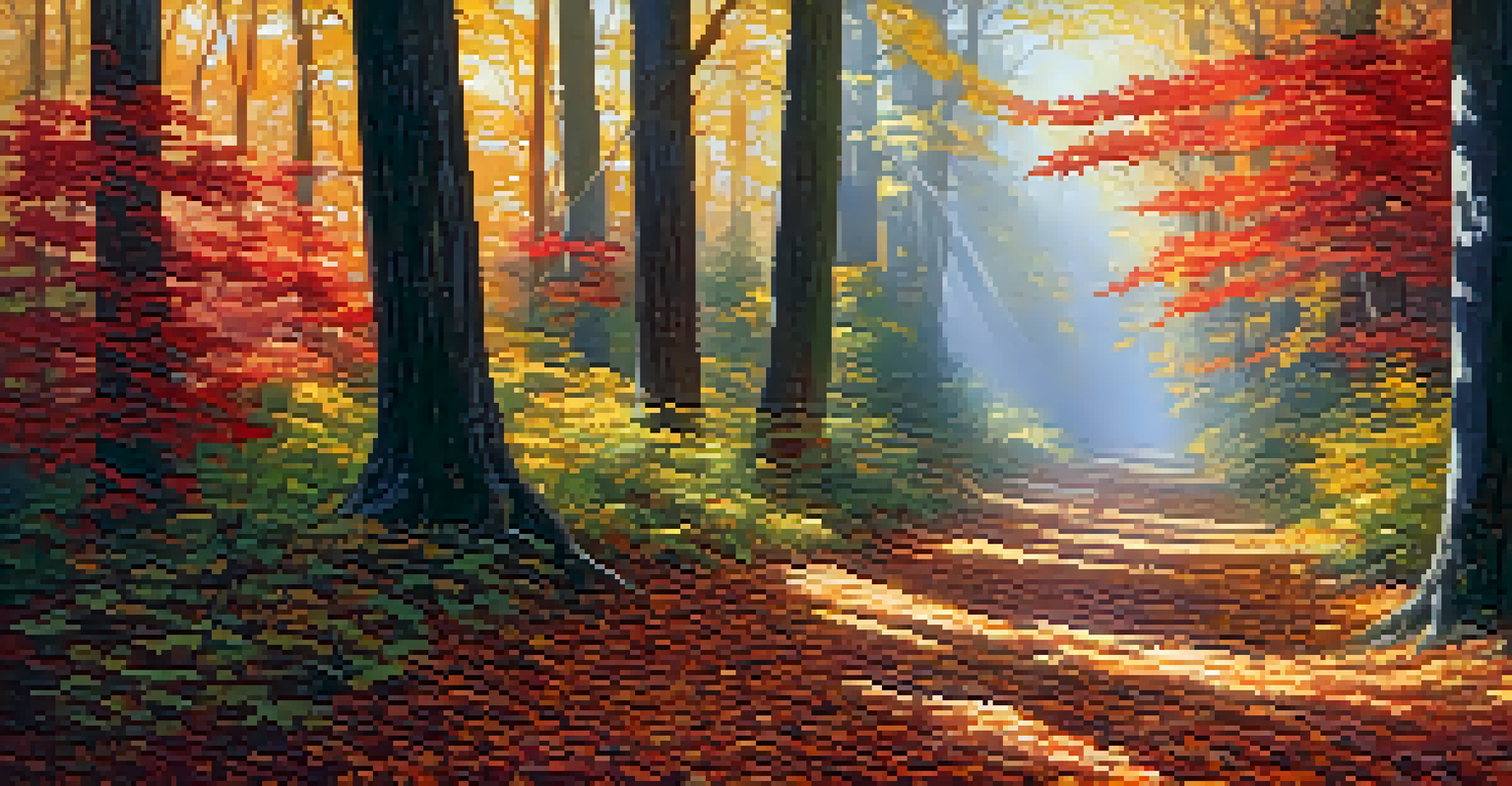Spiritual Themes in Transcendentalist Landscape Paintings

Understanding Transcendentalism and Its Roots
Transcendentalism emerged in the early 19th century, primarily in America, as a philosophical movement that emphasized the inherent goodness of people and nature. This ideology encouraged individuals to seek a deeper connection with the natural world, reflecting a belief in the divine presence in all things. Think of it as a bridge between nature and spirituality, where the outdoors becomes a canvas for exploring profound truths.
In the presence of nature, a wild delight runs through the man, in spite of real sorrows.
Key figures like Ralph Waldo Emerson and Henry David Thoreau played pivotal roles in shaping this movement, advocating for self-reliance and personal insight. They believed that by immersing oneself in nature, one could transcend the ordinary and connect with a higher spiritual reality. Through their writings and philosophies, they inspired artists to depict landscapes that resonated with these ideals.
In essence, understanding Transcendentalism provides a foundational lens through which we can appreciate the spiritual themes that permeate the landscape paintings of this era. It’s not just about the physical beauty of nature, but about the deeper meanings and connections that lie beneath the surface.
Nature as a Spiritual Entity in Art
For Transcendentalist painters, nature was more than just scenery; it was a spiritual entity that conveyed deeper truths. Artists like Thomas Cole and Frederic Edwin Church infused their works with a sense of reverence for the natural world, often portraying landscapes that seemed to pulse with spiritual energy. When you look at these paintings, it’s as if nature itself is inviting you to contemplate its mysteries.

These artists often employed techniques such as light and shadow to create a sense of drama and to highlight the divine presence within landscapes. For instance, the use of luminous skies and dramatic vistas in Cole's works evokes a feeling of awe, encouraging viewers to reflect on their own existence and place within the universe. This approach aligns perfectly with the Transcendentalist belief that nature is a manifestation of the divine.
Transcendentalism's Core Ideals
Transcendentalism emphasizes the inherent goodness of people and nature, encouraging individuals to connect deeply with the natural world.
Through their depictions of nature, these artists sought to inspire a spiritual awakening in their audience, urging them to recognize the sacredness of the world around them. Each brushstroke is a reminder that, in the embrace of nature, one can find peace, inspiration, and a connection to something greater.
Symbolism in Transcendentalist Landscape Paintings
Symbolism plays a crucial role in conveying the spiritual themes found in Transcendentalist landscape art. Artists often infused their works with symbols that represented broader concepts, such as the journey of life, the passage of time, and the quest for enlightenment. For example, a solitary tree might symbolize strength and resilience, while a winding river could represent life’s journey.
I took a walk in the woods and came out taller than the trees.
These symbols invite viewers to look beyond the surface and explore the deeper meanings embedded within the artwork. When you observe a painting depicting a vast, open sky, it could evoke feelings of freedom and possibility, encouraging personal reflection on one’s aspirations and dreams. This layer of symbolism aligns with the Transcendentalist idea that nature serves as a mirror for the human soul.
By recognizing these symbols, viewers can engage more fully with the spiritual narratives woven into the landscapes. This makes each painting not just a visual experience but a profound dialogue between the artist, nature, and the observer.
The Role of Light in Transcendentalist Art
Light is a powerful element in Transcendentalist landscape paintings, often used to symbolize divine presence and enlightenment. Artists like Church mastered the interplay of light and shadow to create an almost ethereal quality in their works. When you see a sunbeam breaking through clouds in a painting, it’s not just a beautiful scene; it’s a metaphor for hope and spiritual awakening.
This technique serves to draw viewers’ eyes to specific areas, inviting them to ponder the significance of light in their own lives. The way light illuminates a landscape can evoke feelings of tranquility and connection, reinforcing the notion that nature is a source of spiritual nourishment. It’s as if the artist is saying, ‘Look here, this is where the divine touches the earth.’
Symbolism in Landscape Art
Transcendentalist landscape paintings use symbolism to convey spiritual themes, inviting viewers to explore deeper meanings within the artwork.
In this way, light becomes more than a simple artistic tool; it transforms into a spiritual guide that leads observers toward deeper understanding. Each play of light serves as a reminder of the transcendental truths waiting to be discovered in the natural world.
Emotional Responses to Nature in Art
The emotional responses elicited by Transcendentalist landscape paintings are profound and varied. Viewers often find themselves moved by the beauty of nature depicted on canvas, triggering feelings of nostalgia, peace, or even a sense of longing. This emotional depth reflects the Transcendentalist belief in the interconnectedness of human emotions and the natural world.
When standing before a grand landscape, it’s common to feel a sense of awe that transcends the physical image. This reaction is a testament to the power of art to evoke feelings that resonate on a spiritual level, connecting us with something beyond ourselves. For many, these paintings become a source of solace and inspiration, providing a moment of reflection in a hectic world.
Thus, the emotional landscape created by these artists serves as a bridge between the viewer and the spiritual essence of nature. It invites us to not only appreciate the beauty around us but to also explore our own feelings and thoughts in relation to the natural world.
Influence of Religion and Spirituality
Religion and spirituality significantly influenced the themes present in Transcendentalist landscape art, as many artists sought to explore the divine through nature. The movement was deeply rooted in the belief that nature was a reflection of God’s creation, and this perspective shaped how artists approached their work. This connection to spirituality is evident in the majestic landscapes that evoke a sense of reverence and awe.
For instance, many paintings feature natural elements such as mountains and rivers, which are often viewed as symbols of strength and purity. By depicting these elements, artists expressed their spiritual beliefs and invited viewers to contemplate their own relationship with the divine. The grandeur of the landscapes serves as a reminder of the vastness of creation and the mysteries of existence.
Legacy of Spiritual Themes Today
The spiritual themes from Transcendentalist art continue to influence contemporary artists, fostering a renewed appreciation for the sacredness of nature.
In essence, the spiritual themes in these artworks are intertwined with religious beliefs, creating a rich tapestry of meaning. Each painting becomes a reflection of the artists’ spiritual journeys, encouraging viewers to embark on their own quests for understanding and connection.
Legacy of Spiritual Themes in Contemporary Art
The influence of spiritual themes from Transcendentalist landscape paintings can still be seen in contemporary art. Many modern artists continue to explore the relationship between nature and spirituality, drawing inspiration from the ideals set forth by their predecessors. This legacy encourages a renewed appreciation for the natural world and its potential to evoke profound emotional and spiritual responses.
For example, contemporary artists might use mixed media to create immersive installations that invite viewers to engage with natural elements. This approach echoes the Transcendentalist belief in the sacredness of nature and encourages a dialogue between the observer and the environment. It’s a reminder that the quest for spiritual connection through art is a timeless endeavor.

As we reflect on the rich history of Transcendentalist landscape art, we can appreciate how these spiritual themes continue to resonate today. They remind us that in our fast-paced lives, we can still find solace and inspiration in the beauty of nature, just as artists did over a century ago.